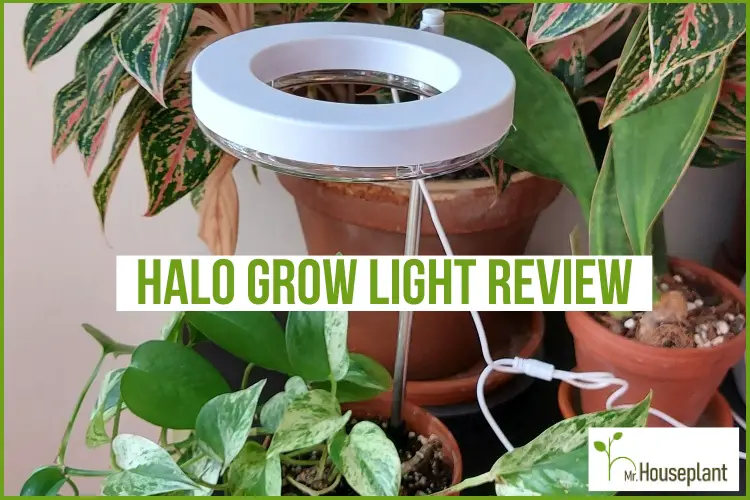
Are you thinking of buying a Halo Grow Light, but you’re not sure if it’s the right choice for your indoor plant? Don’t worry, this Halo grow light review will give you all the necessary info, and help you make the final decision.
Products similar to Halo Grow light
| Product | Rating | Usage | Review |
|---|---|---|---|
| Sansi 15W | small & medium plants | read | |
| Dommia | small & medium plants | read | |
| Sansi 36W | large plants | read |
Halo Grow Light is a beautiful light, with low brightness, that only provides a sufficient amount of light for small low light tolerant plants. It only works well if you keep it on for 16 hours/day at a distance of less than 2” from the plants. If you want a good grow light, much better alternatives are Sansi 15W or Dommia – brighter at a lower price.
If you want affordable grow lights, consider these cheap grow light options or if you are willing to spend a bit more, check out the best grow lights for house plants.

This plant light can be full spectrum or purple
SPECIFICATION:
- Wattage: 30 watts
- PPFD (at distance of 1 foot/30 cm): 15 μmol/m2/sec
- DLI (at 1 foot for 16 hours): 0.86 mol/m2/day
- PPFD (at distance of 2”/5 cm): 70 μmol/m2/sec
- DLI (at 2”/5 cm for 16 hours): 4 mol/m2/day
- Color Temperature: 6,000 K (cool white)
- Package Dimensions: 13.3 by 7.64 by 1.46 inches
- Warranty: 1-year warranty
- Features: automatic on-off timer (depending on the brand), dimmer (depending on the brand), extendable height
Halo Grow Light is a beautiful light, with low brightness, that only provides a sufficient amount of light for small low light tolerant plants. It only works well if you keep it on for 16 hours/day at a distance of less than 2” from the plants. If you want a good grow light, much better alternatives are Sansi 15W or ACKE – brighter at a lower price.

This plant light can be full spectrum or purple
If you want affordable grow lights, consider these cheap grow light options or if you are willing to spend a bit more, check out the best grow lights for house plants.
Specification:
- Wattage: 30 watts
- PPFD (at distance of 1 foot/30 cm): 15 μmol/m2/sec
- DLI (at 1 foot for 16 hours): 0.86 mol/m2/day
- PPFD (at distance of 2”/5 cm): 70 μmol/m2/sec
- DLI (at 2”/5 cm for 16 hours): 4 mol/m2/day
- Color Temperature: 6,000 K (cool white)
- Package Dimensions: 13.3 by 7.64 by 1.46 inches
- Warranty: 1-year warranty
- Features: automatic on-off timer (depending on the brand), dimmer (depending on the brand), extendable height
PROS
CONS
- Beautiful design
- Suitable for small low light tolerant potted plants
- Easy to use
- Can automatically turn off (timer included)
- Extremely low brightness
- Needs to be placed very close to plants, otherwise, it won’t help plant growth
- Not suitable for larger plants
- Not suitable for medium light and bright light plants
- Expensive for the amount of light it provides
PROS
- Beautiful design
- Suitable for small low light tolerant potted plants
- Easy to use
- Can automatically turn off (timer included)
CONS
- Extremely low brightness
- Needs to be placed very close to plants, otherwise, it won’t help plant growth
- Not suitable for larger plants
- Not suitable for medium light and bright light plants
- Expensive for the amount of light it provides
Halo Grow Light FAQ
Which Halo LED Grow Lights Did You Test?
I tested 2 brands of halo LED grow lights (Brite Labs and GooingTop). Most halo grow lights are of similar quality. As they don’t consume a lot of power (5W to 10W), they aren’t physically capable of producing a lot of light. Also due to their small size, they cannot provide light for indoor plants wider than several inches.
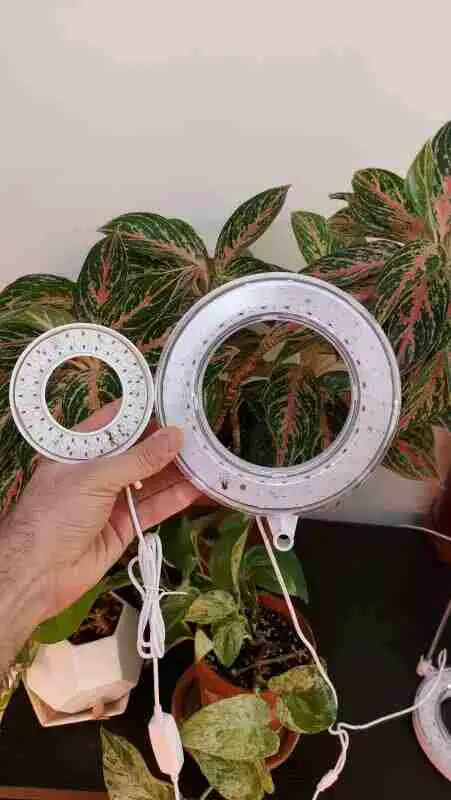
GooingTop LED grow light on the left and Brite Labs plant halo on the right
How To Install Halo Grow Light?
Halo Grow Light is very easy to install, make sure to follow these steps:
- Connect the pole to the halo grow light
- Connect the plastic fitting that goes into the soil with the pole
- Insert the plastic fitting into the soil
- Adjust the distance between the light and the plant
- Plug the light in and turn it on
- Set the timer
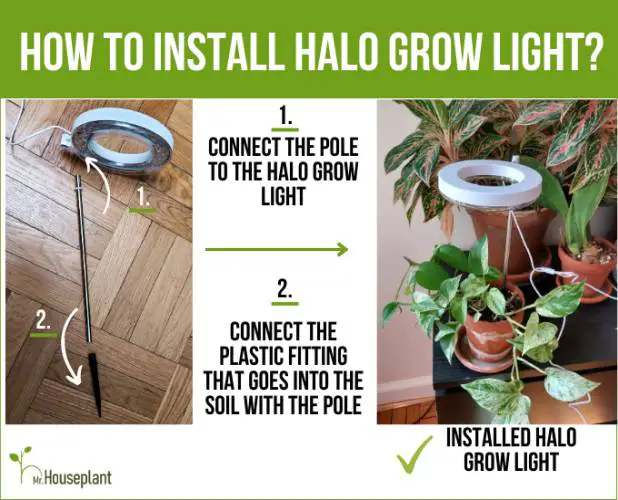
Installing this light for indoor plants is simple and requires a few steps only
What Is The Color Of This Light?
Halo Grow Light has several color options, depending on the brand. It usually comes in purple or full spectrum (warm white or cool white).
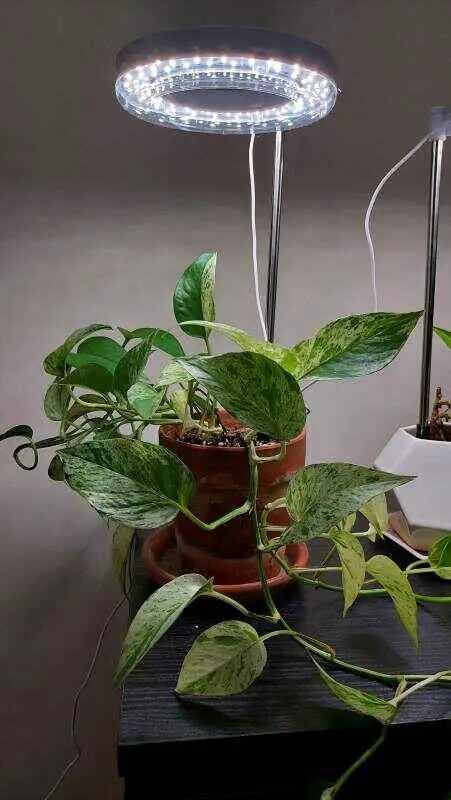
Full spectrum light from Brite Labs
Which Indoor Plants Can I Use This Light On?
You can use the halo plant light on small plants that are low-light tolerant. Make sure to keep the light at 2” or closer to the plants. However, these plants will do well even without this light. I do not recommend growing medium light plants and bright light plants, nor large low light plants with the halo light, as it cannot provide sufficient amounts of light.
Better options are Sansi 15W or Dommia LED grow lights, which are much brighter and more affordable.
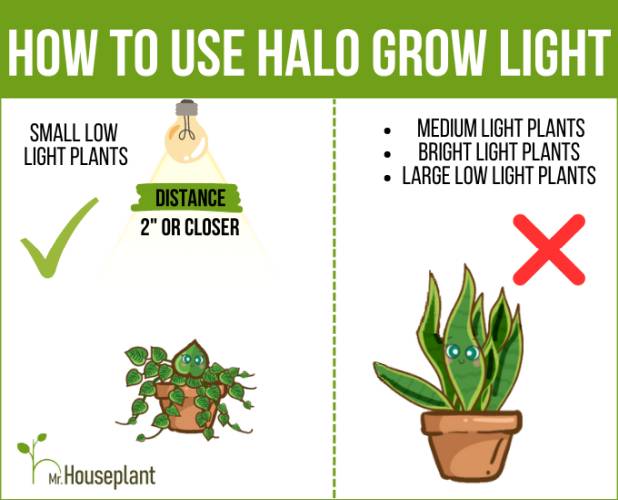
Led grow light helps small indoor plants growth
How Close Should I keep The Light To My Plants? And How Many Hours?
You should keep the Halo LED grow light at a distance of 2” or less for 16 hours/day. If you place the light further away, it will not provide sufficient light for your plants. Even at the distance of 2” it provides a very low amount of light that is only suitable for low light tolerant plants.
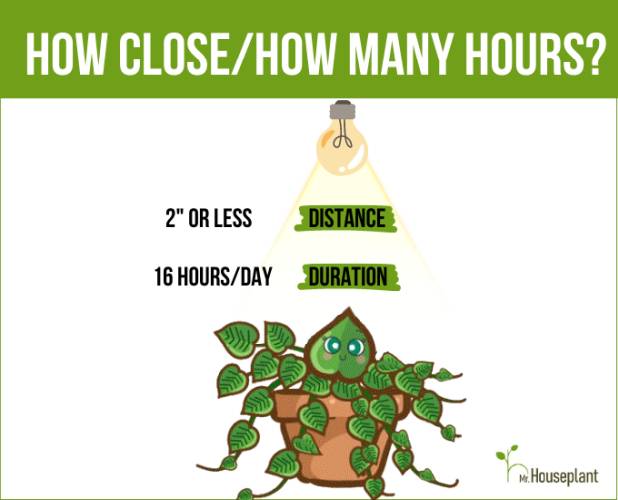
The duration under this led grow light for your indoor plants should be 16 hours (daily)
What Is The Lifespan Of A Halo Grow Light?
The lifespan of a Halo Grow Light is 50,000 hours, according to the manufacturer.
Can Halo Grow Light Damage My Plants?
No, Halo Grow light cannot damage your plants. The light is so weak, that even if the grow light is pressed against your plants, it will not damage the leaves because it doesn’t generate enough heat to cause damage.
This plant light cannot replicate natural sunlight.
Does The Plant Halo Work?
No, the Plant Halo grow light does not work. It is not a good enough light to be recommended for plants due to its low brightness. If kept at 2 inches from the plants for 8-16 hours/day, it will provide 2-4 DLI (Daily Light Integral), which is only good for low light tolerant plants. However, most people will not keep the light that close to their plants. At larger distances, the light becomes useless.
At a distance of 1 foot (30 cm), if the light is kept on for 16 hours, it provides less than 1 DLI of light, which makes it pretty much useless.
Research
Why you should trust Mr. Houseplant?
I have extensive experience with growing indoor plants (over a decade), and over 6 years of growing indoor plants under grow lights. I have used different types of grow lights, such as LED, fluorescent, fluorescent bulbs, and full spectrum lights, by many well-known and less-known brands of grow lights. Additionally, I owned a venus flytrap production business for 3 years, where I grew venus flytraps with no natural light, just by using grow lights.
How Mr. Houseplant Selected And Tested Products
I identified the key decision-making factors for grow lights and tested two brands of halo lights to see how they measure for each of the factors. The key decision-making factors were: 1) brightness 2) design 3) price 4) glare 5) unique features that set it apart from the competition 6) warranty 7) ease of setup. I tested both lights with a PAR meter (a grow light meter) at different distances to determine the light intensity (brightness).
Conclusion
Halo grow light is a very weak light that doesn’t produce enough light to help your plant growth. Some of the much better options for your indoor plant are Sansi 15W or Dommia. If you want affordable grow lights, consider these cheap led grow lights options or if you are willing to spend a bit more, take a look at the best grow lights for indoor plants.
Products similar to Halo Grow light
Yours Truly,

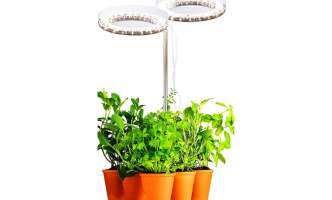


Related Posts
Spider Farmer Grow Light Review (JULY 2023)
Top 3 Soil pH Testers (July 2023)
Soltech Solutions Vita Grow Light (2023)